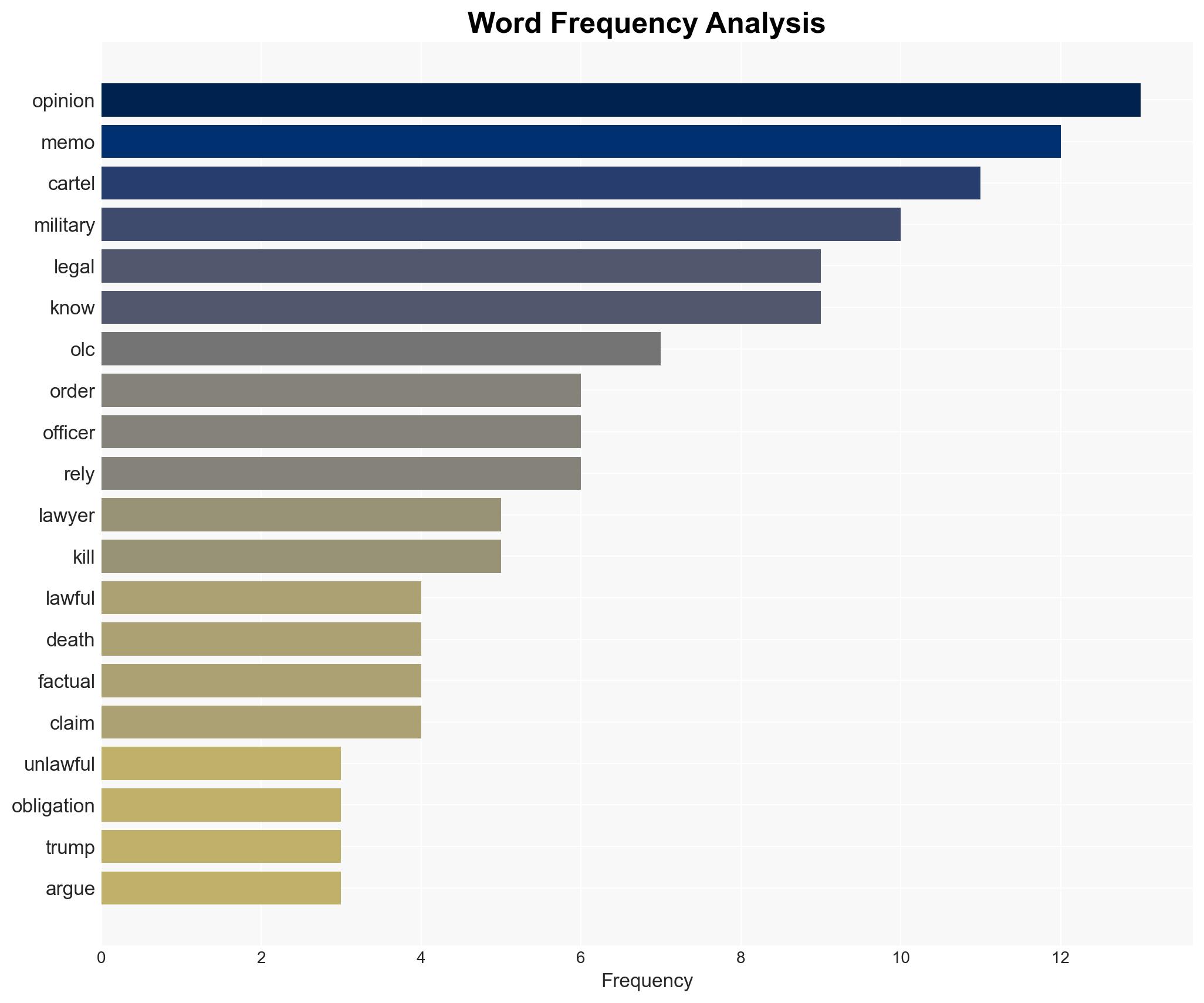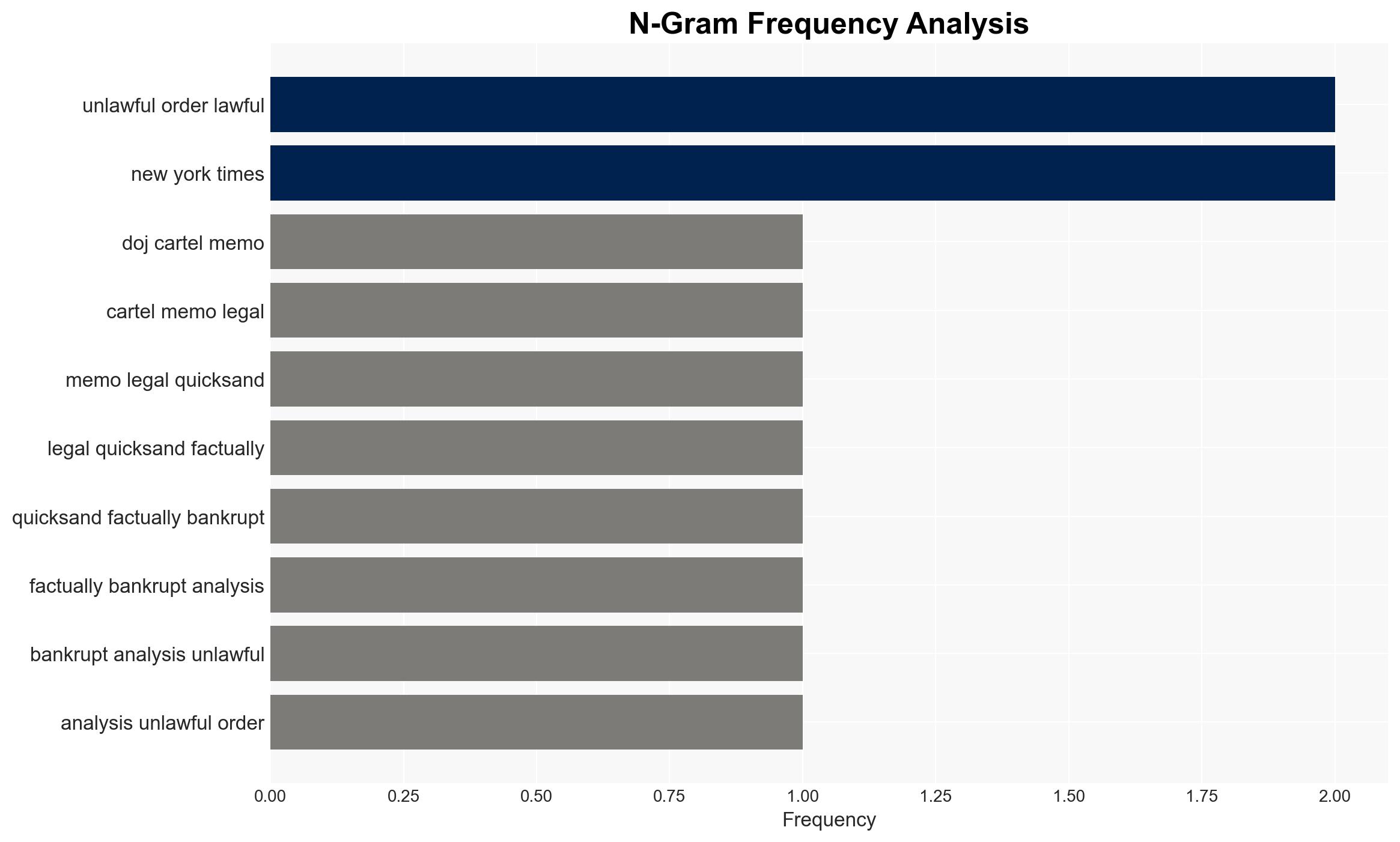DOJ Cartel Memo Raises Legal Concerns Amid Allegations of Unlawful Orders and Military Compliance
Published on: 2025-11-26
AI-powered OSINT brief from verified open sources. Automated NLP signal extraction with human verification. See our Methodology and Why WorldWideWatchers.
Intelligence Report: The DOJs Cartels Memo Is Legal Quicksand
1. BLUF (Bottom Line Up Front)
The Department of Justice’s (DOJ) memo on cartels presents significant legal and operational risks due to its questionable factual basis and legal reasoning. The memo’s reliance on potentially false premises could lead to unlawful military actions and international legal challenges. The most likely hypothesis is that the memo’s conclusions are legally unsound, posing risks to U.S. military personnel and international relations. Overall confidence in this assessment is moderate, given the lack of complete information.
2. Competing Hypotheses
- Hypothesis A: The DOJ memo is legally sound and provides a valid basis for military action against cartels. Supporting evidence includes the memo’s issuance by the Office of Legal Counsel (OLC), which typically provides authoritative legal opinions. However, contradictions arise from the memo’s reliance on disputed facts and the inclusion of potential legal defenses, indicating awareness of its weaknesses.
- Hypothesis B: The DOJ memo is legally flawed and based on erroneous factual claims, potentially leading to unlawful military actions. This hypothesis is supported by the memo’s reliance on disputed claims about cartel activities and its unusual inclusion of legal defenses, suggesting a lack of confidence in its conclusions. Reports of senior national security lawyers doubting the memo further support this view.
- Assessment: Hypothesis B is currently better supported due to the memo’s reliance on questionable facts and the inclusion of legal defenses, indicating a recognition of its legal vulnerabilities. Key indicators that could shift this judgment include new evidence validating the memo’s claims or authoritative legal endorsements.
3. Key Assumptions and Red Flags
- Assumptions: The memo’s legal reasoning is based on accurate factual claims; military personnel will act based on the memo’s guidance; international legal norms will be enforced consistently.
- Information Gaps: Detailed evidence supporting the memo’s factual claims about cartel activities; internal DOJ deliberations and legal reviews of the memo.
- Bias & Deception Risks: Potential cognitive bias in over-relying on OLC opinions; source bias from DOJ’s internal perspectives; possible manipulation of facts to justify military actions.
4. Implications and Strategic Risks
The DOJ memo’s legal vulnerabilities could lead to significant strategic risks if military actions based on it are challenged internationally. This development could strain U.S. relations with affected countries and undermine the credibility of U.S. legal and military institutions.
- Political / Geopolitical: Potential diplomatic fallout with countries implicated by the memo; increased scrutiny from international legal bodies.
- Security / Counter-Terrorism: Possible escalation of violence if cartels retaliate against perceived U.S. military actions.
- Cyber / Information Space: Potential for misinformation campaigns by adversaries exploiting legal ambiguities to undermine U.S. credibility.
- Economic / Social: Disruption of trade and economic relations with countries involved; potential social unrest if military actions are perceived as unlawful.
5. Recommendations and Outlook
- Immediate Actions (0–30 days): Conduct a thorough legal review of the memo’s claims; engage with international partners to clarify U.S. intentions and legal positions.
- Medium-Term Posture (1–12 months): Develop resilience measures to mitigate potential diplomatic and legal fallout; strengthen partnerships with affected countries to address cartel threats collaboratively.
- Scenario Outlook:
- Best: Legal review validates the memo, leading to coordinated international actions against cartels.
- Worst: Military actions based on the memo result in international legal challenges and diplomatic isolation.
- Most-Likely: Continued legal and diplomatic scrutiny, with limited military actions pending further validation.
6. Key Individuals and Entities
- Not clearly identifiable from open sources in this snippet.
7. Thematic Tags
Structured Analytic Techniques Applied
- Cognitive Bias Stress Test: Expose and correct potential biases in assessments through red-teaming and structured challenge.
- Bayesian Scenario Modeling: Use probabilistic forecasting for conflict trajectories or escalation likelihood.
- Network Influence Mapping: Map relationships between state and non-state actors for impact estimation.
Explore more:
National Security Threats Briefs ·
Daily Summary ·
Support us





